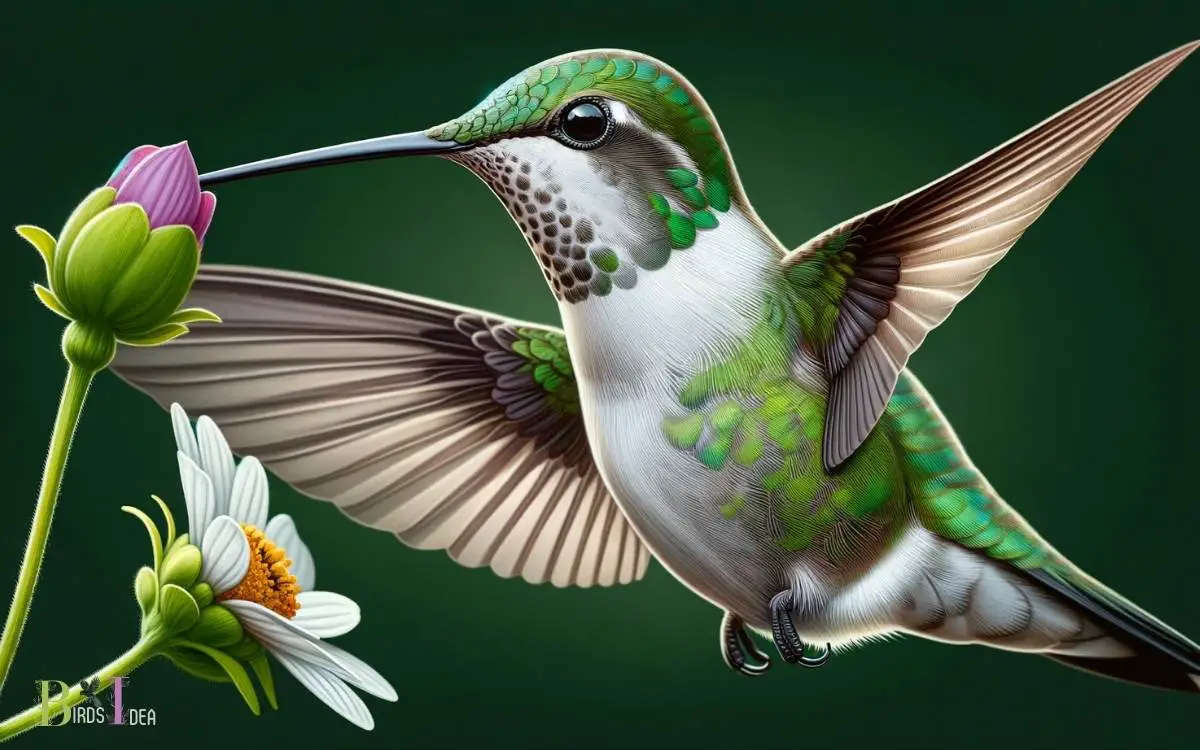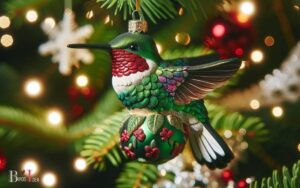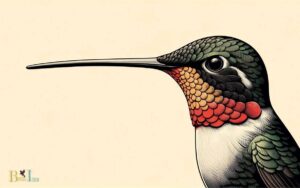What Does the Female Ruby Throated Hummingbird Look Like?
The female Ruby-Throated Hummingbird is less flamboyant than the male, with a green back and crown, and grayish-white underside. Lacking the male’s radiant throat patch, she has a white throat with fine streaks or spots.
The Ruby-Throated Hummingbird is a species known for sexual dimorphism, meaning males and females have different appearances.
Here’s what typically distinguishes a female Ruby-Throated Hummingbird:
These characteristics help birdwatchers and enthusiasts distinguish between the sexes in the field.
Sporting subtle elegance, the female Ruby-Throated Hummingbird is a master of disguise, merging seamlessly with the verdant hues of her habitat.

Key Takeaway
Plumage Colors
Displaying a subtle green and white coloration, the female Ruby Throated Hummingbird’s plumage contrasts with the vibrant red throat of the male.
The upper plumage of the female is a pale green, while the undersides are a grayish-white, often with a faint greenish tinge.
The tail feathers are a dusky green with white tips. This coloration serves as a form of camouflage, allowing the female to blend into her surroundings while she incubates her eggs or tends to her nest.
The subdued coloration also provides protection from predators as she goes about her daily activities.
The female’s plumage is an exquisite example of evolutionary adaptation, allowing her to thrive in the diverse habitats she inhabits across North America.
Body Size and Shape
The body size and shape of the female Ruby-throated Hummingbird are key features that distinguish it from other species.
Understanding these physical characteristics is important for accurate identification in the field.
By examining the body proportions, feather structure, and overall dimensions, we can gain insight into the unique adaptations and behaviors of this remarkable bird.
Female Hummingbird Body
The female Ruby Throated Hummingbird has a slender and compact body, typically measuring 2.8 to 3.5 inches in length.
Female hummingbirds possess distinct physical attributes that set them apart from their male counterparts:
- Body Size: Their small size allows for agility and precision during flight, enabling them to hover and maneuver effortlessly.
- Body Shape: The streamlined body shape, with a short neck and slender wings, contributes to their exceptional aerodynamic capabilities, facilitating rapid movement and quick changes in direction.
- Feather Structure: Their feathers are lightweight and iridescent, aiding in efficient energy expenditure during flight and providing camouflage in their natural habitats.
These physical characteristics are crucial to the female Ruby Throated Hummingbird’s survival and play a significant role in their behavior and ecological interactions.
Ruby-Throated Hummingbird Appearance
With a slender and compact body measuring 2.8 to 3.5 inches in length, the female Ruby Throated Hummingbird exhibits exceptional agility and precision during flight, owing to its small size and streamlined body shape.
| Aspect | Description |
|---|---|
| Size | 2.8 to 3.5 inches in length |
| Weight | Approximately 3 to 4 grams |
| Body Shape | Compact and streamlined for agility |
The Ruby Throated Hummingbird’s diminutive size enables it to hover effortlessly and maneuver with great dexterity.
Additionally, its streamlined body shape reduces air resistance, allowing it to reach impressive speeds during flight.
These physical characteristics are crucial adaptations for accessing nectar from flowers and evading predators.
The small size and aerodynamic design of the female Ruby Throated Hummingbird’s body make it an extraordinary aerial performer in the avian world.
Tail Feathers
A female Ruby Throated Hummingbird’s tail feathers are distinguished by their subtle iridescent green coloration and tapered shape. These unique features play a vital role in the bird’s aerial agility and courtship displays.
The tail feathers of the female Ruby Throated Hummingbird serve several important functions:
- Iridescent Green Coloration: The iridescent green coloration of the tail feathers serves as a form of visual communication during courtship displays, signaling the bird’s health and reproductive fitness to potential mates.
- Tapered Shape: The tapered shape of the tail feathers contributes to the hummingbird’s remarkable maneuverability during flight, allowing for precise and rapid changes in direction while foraging for nectar and insects.
- Stability and Balance: Additionally, the tail feathers provide stability and balance during hovering and intricate aerial movements, enabling the bird to navigate with exceptional precision.
Bill Characteristics
Characterized by its slender and elongated shape, the bill of the female Ruby Throated Hummingbird plays a crucial role in facilitating precise foraging and feeding behaviors.
The bill is adapted for capturing small insects and reaching into deep-throated flowers for nectar. It consists of a long, thin upper mandible and a shorter, slightly curved lower mandible.
The bill’s fine tip allows for delicate extraction of nectar while its flexibility enables it to probe flowers with ease.
The bill is also used for catching tiny insects mid-air, showcasing the bird’s remarkable agility and precision.
The bill’s specialized structure reflects the hummingbird’s unique feeding habits and evolutionary adaptations. This remarkable feature is essential for the bird’s survival and thriving in its habitat.
Throat Patch
The female Ruby Throated Hummingbird has a distinctive throat patch that is an important identifying feature.
This patch, also known as a gorget, plays a crucial role in differentiating female hummingbirds from their male counterparts.
Here are some key characteristics of the throat patch:
- Coloration: The female’s throat patch is usually white or pale in color, often with subtle speckling or light markings.
- Size and Shape: The throat patch is relatively small compared to the male’s vibrant red gorget. It is often round or slightly elongated in shape, situated at the base of the throat.
- Molt Patterns: The throat patch can display variations in color and pattern during molting periods, with some individuals showing a change in hue or intensity.
This distinct feature sets the female Ruby Throated Hummingbird apart and aids in accurate identification.
Wing Pattern
The wing pattern of the female Ruby Throated Hummingbird is characterized by distinctive markings, vibrant feather patterns, and unique flight characteristics.
These markings play a crucial role in identifying and distinguishing the female Ruby Throated Hummingbird from other species.
By examining the intricate details of the wing pattern, one can gain valuable insights into the species’ behavior and ecological adaptations.
Distinctive Wing Markings
How is the distinctive wing pattern of the female Ruby Throated Hummingbird characterized?
The female Ruby Throated Hummingbird’s wing pattern is characterized by the following features:
- White Wing Tips: The primary feathers of the female’s wings have small white tips that are visible in flight and create a delicate, lacy pattern against the dark plumage.
- Pale Edging: The female’s wings display pale edging on the feathers, giving a subtle but distinctive contrast to the darker coloration of the wings.
- Thin, White Line: A thin, white line extends from the base of the wing to the body, adding a unique and intricate detail to the overall wing pattern.
These distinctive wing markings contribute to the female Ruby Throated Hummingbird’s graceful and elegant appearance, setting her apart from other hummingbird species.
Vibrant Feather Patterns
Vibrantly displaying intricate feather patterns, the female Ruby Throated Hummingbird’s wing pattern captivates observers with its delicate beauty.
The primary feathers are a lustrous metallic green, while the secondary feathers exhibit a rich rufous tone.
When in flight, the wings create a stunning visual display as the green and rufous colors interplay, catching and reflecting sunlight.
The wing feathers also feature subtle iridescent patches that shimmer with varying hues depending on the angle of the light. These iridescent patches add a mesmerizing dimension to the overall wing pattern.
The blend of colors and the iridescence of the feathers not only serve as a visual delight but also aid in camouflaging the hummingbird amidst the foliage, providing it with a measure of protection against predators.
Unique Flight Characteristics
With remarkable agility and precision, the female Ruby Throated Hummingbird’s flight showcases its unique wing pattern, enabling it to maneuver swiftly through its environment.
This species exhibits several distinctive flight characteristics:
Wing Morphology:
- The female Ruby Throated Hummingbird possesses long, slender wings that form a nearly straight line when in flight.
- This wing shape allows for rapid acceleration and exceptional maneuverability, essential for reaching nectar-rich flowers and evading predators.
Wingbeat Frequency:
- The wings of the female Ruby Throated Hummingbird beat at an astonishing rate, averaging around 53 beats per second during normal flight and increasing to over 200 beats per second during courtship displays or rapid aerial maneuvers.
Wing Pattern:
- The wings exhibit a subtle iridescence, with hints of green and blue, which catch the light and create a mesmerizing visual effect, aiding in species recognition and mate attraction.
Eye and Facial Markings
The female Ruby Throated Hummingbird exhibits distinct eye and facial markings that contribute to its unique appearance and identification.
This species is characterized by a white postocular spot behind the eye and a dark line extending from the base of the bill and through the eye. The area below the eye is a pale buff color, and the chin and upper throat are a whitish color.
These facial markings are important for distinguishing the female Ruby Throated Hummingbird from other species.
Eye and Facial Markings
- White postocular spot
- Dark line through the eye
- Pale buff color below the eye
These markings aid researchers and birdwatchers in accurately identifying and studying the female Ruby Throated Hummingbird.
Behavior and Flight
In addition to its distinctive eye and facial markings, the female Ruby Throated Hummingbird is known for its agile behavior and remarkable flight capabilities, making it a fascinating subject of study for researchers and birdwatchers alike.
- Hovering: The female Ruby Throated Hummingbird has a unique ability to hover in mid-air, achieved by rapidly flapping its wings in a figure-eight pattern.
- Feeding Behavior: This hummingbird exhibits territorial behavior when it comes to food sources, often defending their feeding areas vigorously.
- Flight Speed: Despite its small size, the female Ruby Throated Hummingbird is capable of reaching impressive flight speeds, sometimes exceeding 30 miles per hour during migratory journeys.
These behaviors and flight capabilities make the female Ruby Throated Hummingbird a captivating species to observe and study.
Molt and Seasonal Changes
During molt and seasonal changes, the female Ruby Throated Hummingbird undergoes a process of shedding and regrowing feathers, adapting to environmental shifts with precision and efficiency.
This allows the bird to maintain its optimal plumage for different seasons and environmental conditions.
The molting process is essential for maintaining the bird’s ability to fly, regulate body temperature, and display vibrant colors for courtship.
The following table illustrates the seasonal changes in the female Ruby Throated Hummingbird’s appearance:
| Season | Plumage |
|---|---|
| Spring | Bright iridescent green on the back |
| Summer | White tips on the outer tail feathers |
| Fall | Muted green and grayish plumage |
| Winter | Dull and pale plumage |
Conclusion
The female ruby-throated hummingbird exhibits vibrant plumage colors, a slender body with a long bill, and distinctive tail feathers.
Its behavior and flight patterns are characteristic of its species, and it undergoes seasonal changes in molt.
Like a precious gem in flight, the female ruby-throated hummingbird is a stunning and fascinating creature to observe in the wild.






